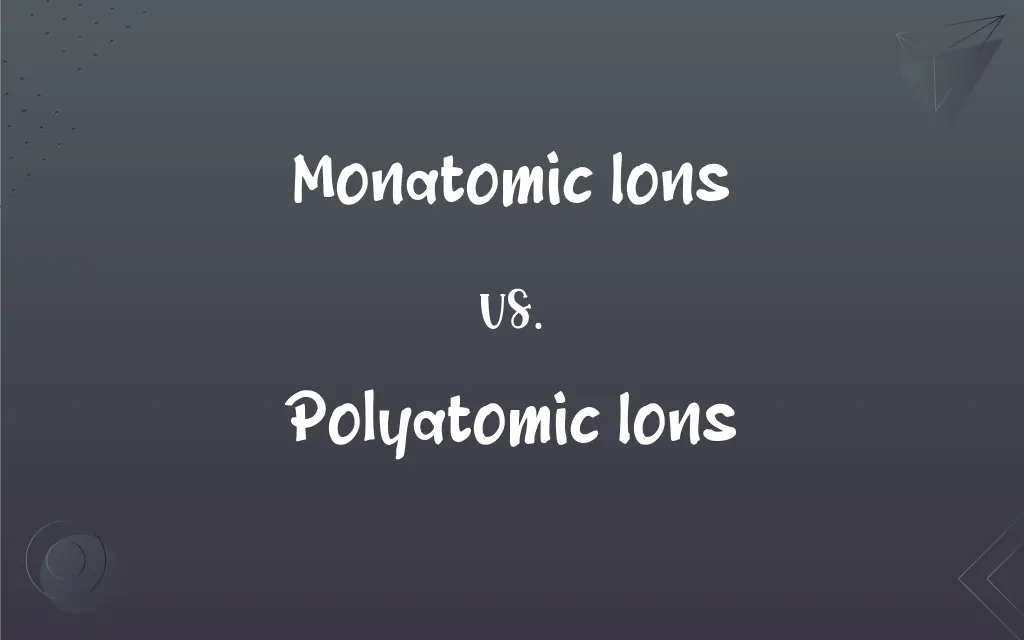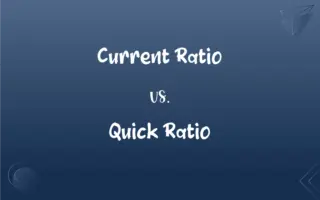Monatomic Ions vs. Polyatomic Ions: What's the Difference?
Edited by Janet White || By Harlon Moss || Updated on October 25, 2023
Monatomic ions consist of a single atom with a charge, while polyatomic ions comprise two or more atoms with a charge.

Key Differences
Monatomic ions and polyatomic ions both play essential roles in chemistry, particularly in ionic bonding. Monatomic ions are ions formed from a single atom, which means they consist of just one type of atom that has either lost or gained electrons. In contrast, polyatomic ions are formed from two or more atoms covalently bonded together, with the group having an overall charge.
In terms of composition, monatomic ions are simpler. They're just individual atoms carrying a positive or negative charge, such as a sodium ion (Na⁺) or a chloride ion (Cl⁻). On the other hand, polyatomic ions are more complex because they consist of multiple atoms, like the hydroxide ion (OH⁻) or the ammonium ion (NH₄⁺).
When considering their roles in compounds, monatomic ions typically combine with oppositely charged ions to form ionic compounds. For instance, a sodium ion (Na⁺) can combine with a chloride ion (Cl⁻) to produce table salt (NaCl). Meanwhile, polyatomic ions can combine with other ions (either monatomic or polyatomic) to form various compounds, such as calcium carbonate (CaCO₃) or ammonium chloride (NH₄Cl).
The formation of monatomic ions results from a single atom losing or gaining electrons, thus acquiring a charge. For polyatomic ions, the process is a bit more involved. The atoms within the ion share electrons through covalent bonds, and the overall group has an imbalance of electrons, leading to its charge.
In terms of nomenclature, monatomic ions usually get their names from the element, with "ion" added or a suffix change (like "ide" for anions). Polyatomic ions have standard names that often don't directly reflect the constituent elements, such as "hydroxide" or "carbonate."
ADVERTISEMENT
Comparison Chart
Composition
Single atom with a charge.
Two or more atoms with a charge.
Examples
Na⁺, Cl⁻
OH⁻, NH₄⁺
Bonding
Typically forms ionic bonds.
Can be part of ionic or covalent compounds.
Formation
Loss or gain of electrons by one atom.
Covalent bonding within atoms, with an overall charge.
Nomenclature
Based on the element's name.
Standard names, often not directly reflecting elements.
ADVERTISEMENT
Monatomic Ions and Polyatomic Ions Definitions
Monatomic Ions
Monatomic ions carry either a positive or negative charge.
Chloride, Cl⁻, is a negatively charged monatomic ion.
Polyatomic Ions
Polyatomic ions play essential roles in many chemical reactions.
Calcium carbonate, CaCO₃, is formed with the polyatomic ion carbonate.
Monatomic Ions
Monatomic ions can be cations (positive) or anions (negative).
Ca²⁺ is a cationic monatomic ion.
Polyatomic Ions
Polyatomic ions have specific naming conventions.
Sulfate, SO₄²⁻, is one of the many named polyatomic ions.
Monatomic Ions
Monatomic ions are prevalent in ionic compounds.
Sodium chloride is a compound formed by the monatomic ions Na⁺ and Cl⁻.
Polyatomic Ions
Polyatomic ions form through covalent bonding within the atoms.
The nitrate ion, NO₃⁻, is made of nitrogen and oxygen covalently bonded with an overall negative charge.
Monatomic Ions
Monatomic ions are ions made up of a single atom.
The ion Na⁺ is an example of monatomic ions.
Polyatomic Ions
Polyatomic ions consist of multiple atoms with a charge.
Carbonate, CO₃²⁻, is a typical example of polyatomic ions.
Monatomic Ions
Monatomic ions form when atoms lose or gain electrons.
When potassium loses an electron, it becomes a monatomic ion K⁺.
Polyatomic Ions
Polyatomic ions can be positively or negatively charged.
Ammonium, NH₄⁺, is a positively charged polyatomic ion.
FAQs
Are monatomic ions always charged?
Yes, by definition, monatomic ions always carry a charge.
How do polyatomic ions differ?
Polyatomic ions consist of two or more atoms with an overall charge.
Do polyatomic ions always have a negative charge?
No, while many do, there are also positively charged polyatomic ions like ammonium (NH₄⁺).
Why are monatomic ions significant in electricity?
They can conduct electricity when dissolved in solutions, making them essential in batteries and other devices.
What are monatomic ions?
Monatomic ions are ions made up of a single atom with a charge.
Are polyatomic ions stable?
They can be stable, especially when part of a compound, but their stability can vary.
How do I recognize a polyatomic ion in a formula?
Look for groupings of multiple elements with an overall charge, such as NO₃⁻ or SO₄²⁻.
Do polyatomic ions exist in nature?
Yes, they're found in various natural substances, like minerals and biological molecules.
Can monatomic ions exist freely in solutions?
Yes, they often exist as free ions in solutions, especially in electrolytes.
Can you give an example of a polyatomic ion?
Yes, sulfate (SO₄²⁻) is a common polyatomic ion.
How can you determine the charge of a monatomic ion?
Often, the charge can be determined by the atom's position in the periodic table.
Are there many types of polyatomic ions?
Yes, there are numerous polyatomic ions, each with distinct compositions and charges.
Can monatomic ions form covalent bonds?
Typically, monatomic ions form ionic bonds, but under certain conditions, they can be involved in covalent interactions.
Is water a polyatomic ion?
Water (H₂O) is a neutral molecule, but when it loses a proton, it becomes the polyatomic ion hydroxide (OH⁻).
How are polyatomic ions named?
They often have standard names, such as "carbonate" for CO₃²⁻ or "phosphate" for PO₄³⁻.
How are monatomic ions formed?
Monatomic ions form when a single atom loses or gains electrons.
Can polyatomic ions have a positive charge?
Yes, for instance, the ammonium ion (NH₄⁺) is positively charged.
Why are monatomic ions important in chemistry?
They are fundamental in forming ionic compounds and conducting electricity in solutions.
Are all monatomic ions metals?
Not always. While many are metals (like Na⁺), nonmetals can also form monatomic ions (like Cl⁻).
Can polyatomic ions be found in our daily lives?
Absolutely! They're present in many household substances, like baking soda (which contains the bicarbonate ion).
About Author
Written by
Harlon MossHarlon is a seasoned quality moderator and accomplished content writer for Difference Wiki. An alumnus of the prestigious University of California, he earned his degree in Computer Science. Leveraging his academic background, Harlon brings a meticulous and informed perspective to his work, ensuring content accuracy and excellence.
Edited by
Janet WhiteJanet White has been an esteemed writer and blogger for Difference Wiki. Holding a Master's degree in Science and Medical Journalism from the prestigious Boston University, she has consistently demonstrated her expertise and passion for her field. When she's not immersed in her work, Janet relishes her time exercising, delving into a good book, and cherishing moments with friends and family.
































































